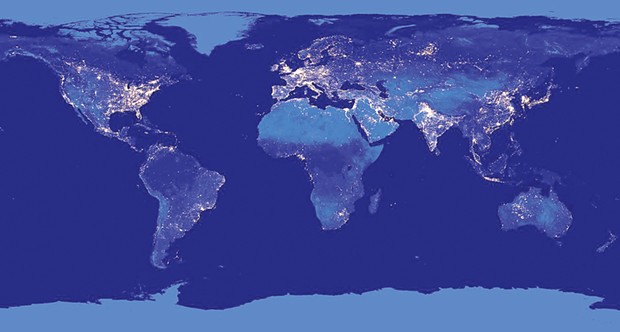[
{
"name": "Top Stories Video Pair",
"insertPoint": "7",
"component": "17087298",
"parentWrapperClass": "fdn-ads-inline-content-block",
"requiredCountToDisplay": "1"
}
]
"The thought of light traveling billions of years from distant galaxies only to be washed out in the last billionth of a second by the glow of the nearest strip mall depresses me no end."
Sönke Johnson, Ecologist at Duke University
Are you appreciating the Milky Way these winter evenings? Beyond your dark-accustomed eyes, you need two assets: no moon in the night sky and being away from lights. Not just city lights, either, but your neighbor's back porch light or the glow from the grow tent across the way. Fact is, if you are seeing that broad swath of ghostly light which Romans called Via Lactea — a spray of milk from Hera's breast — you're lucky. In North America, 80 percent of us can't see it from where we live because there's just too much ambient light around. Yet this is our home, the galaxy in which we live.
It wasn't always thus, of course. Before Edison (among others) invented the electric light bulb in the 1880s, everyone was familiar with the Milky Way. And with stars, too, not just the Big Dipper and other bright ones, but about 2,000 of them, visible now only on moonless nights well away from artificial lights. Not to mention other galaxies. Really dark skies will reveal the glow of the Andromeda galaxy whose light left there two-and-a-half million years ago ("The Farthest Object," Sept. 18, 2008). Andromeda is the farthest naked eye object — unless you've got terrific (read: young) night vision, in which case, check out the Pinwheel galaxy.
Because the Milky Way was so easily seen in the old days, every ancient civilization that we know of invented stories for what they saw: River of Light (Aramaic), Snake of the Skies (Akkadian), Shadow Path (Bengali), Grey Goose Way (Chuvash), Deer's Leap (Georgian), Straw Thief (Kurdish), the Fair Cow's Path (Irish), Silver River (Vietnamese) and on and on. The point is all these people knew it well enough to give it a name and make up stories about it. (I have to wonder how Cherokee people came up with the Way the Dog Ran Away.)
If we humans have lost something by not being able to see the Milky Way, pity the many species with whom we share the planet, who are suffering — some to the point of extinction — because of light pollution. Consider for example:
• Florida's sea-turtle hatchlings, confusing streetlights with the ocean horizon, are being decimated;
• Some 7 million birds annually fly into brightly lit communication towers in North America;
• Moths are drawn to streetlights where they flutter aimlessly to exhaustion and death;
• Monarch butterflies' sophisticated navigation systems are disrupted by artificial lights that disorient their long-distance migrations.
Unlike many other forms of human-generated pollution (such as car exhaust, waterborne estrogen or long-lived insecticides in soils) light pollution is easily fixable. For instance, white and blue light are far more damaging to animals than orange light, which, lumen for lumen, emits less energy. So streetlights can easily be converted to orange sodium vapor and can also be hooded to prevent light spillage. Are you listening, city public works?
Barry Evans (he/him, [email protected]) encourages you to check out our local astronomy group for the monthly observing nights at Kneeland airport, weather permitting: astrohum.org.
more from the author
-
Doubting Shakespeare, Part 2: Problems
- May 2, 2024
-
Doubting Shakespeare, Part 1: Stratfordians vs. anti-Stratfordians
- Apr 25, 2024
-
A Brief History of Dildos
- Apr 11, 2024
- More »
Latest in Field Notes
Readers also liked…
-
Trouble on the Line: The Reality Part 2
- Nov 3, 2022

































